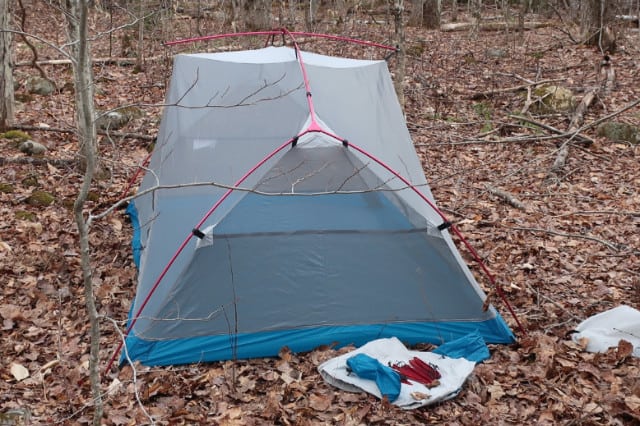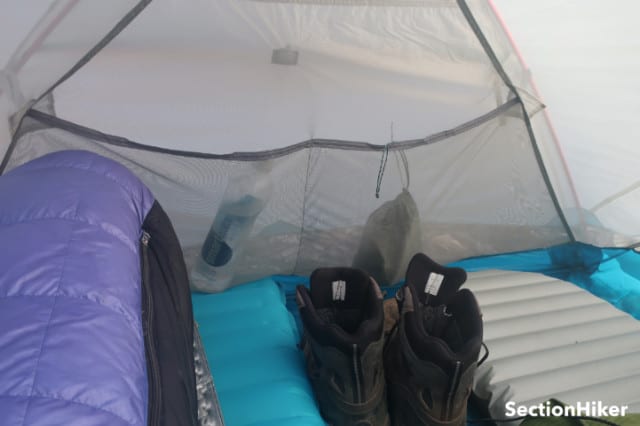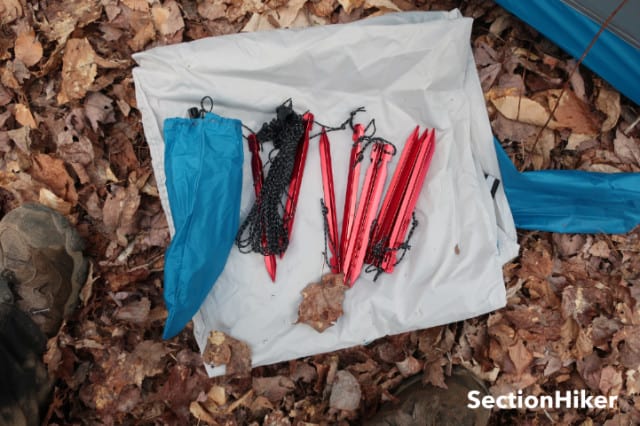The Paria Outdoors Zion 2 is a spacious, freestanding two-person tent with two doors ($155) that can actually fit two people with room to spare. It comes complete with aluminum poles, a footprint, and good quality tent stakes. With a trail weight of 4 lbs 2 oz, the Zion 2 is great for car camping, base camping, and casual backpacking trips where you can split the tent weight with a second person. While it is not as high quality (details below) or cutting edge as a Big Agnes Copper Spur HV UL2 or comparable premium tents, it’s a decent value for 1/3 of the price.
Specs at a Glance
- Capacity: 2 people
- Doors: 2
- Design: double-wall
- Mfg Dimensions – fully rectangular floor, 85-inch length x 53-inch width, 38-inch height
- Actual Measured Dimensions – 82-inch length x 52-inch width, 38-inch height, 6-inch deep floor
- Packed size: 17 inches long by 7 inches in diameter
- Trail weight – 4 lbs. 2 oz. without stakes and footprint (4 lbs. 4 oz. measured)
- Packaged weight – 4 lbs. 15 oz. includes everything (4 lbs 11.5 oz measured)
- Materials:
- Rainfly: 20 Denier rip-stop nylon with dual silicon/PU coatings
- Tent Floor and included footprint: 40 Denier rip-stop nylon with dual silicon/PU coatings
- Mesh: 20 Denier no-see-um fine polyester mesh
- Poles: 8.5 mm 7000-series aluminum alloy
- Waterproofing: Dual silicon/PU coating with factory taped seams, HH 3000 mm
- Accessories: 8 aluminum alloy Y-stakes, reflective 1.75 mm Dyneema guy line, one pole repair splint
Freestanding Tent Design
The Zion 2 is a two-person freestanding tent with two vestibules and D-shaped doors. The tent comes with one 26 segment series 7000 aluminum pole that has two three-way hubs at the ends and a horizontal crossbar in the middle to flatten the ceiling and increase its width. The pole ends slot into grommets in the corners of the inner tent and the inner tent clips to the poles. Aluminum poles are much more durable and break far less frequently than the fiberglass poles that come with inexpensive tents, so this is a big plus. If you buy a tent with fiberglass poles, you’re basically throwing money away.

The rainfly clips to buckles in the corners of the tent, making set up a snap. You still need to stake out the tent corners fully stretch out the length, but it is truly a freestanding tent that you can pick up and move around intact before staking it back down. You can also pitch the tent with the footprint and rainfly only, for a lighter-weight shelter without insect protection. Many big brands make you pay extra for a footprint, so this is another value add.

The inner tent has a true rectangular inner tent floor, not a tapered one, so you can use it with full-width sleeping pads and still have room for your shoes in the tent. I like the fact that both ends of the tent are symmetric because it’s more comfortable that way and you don’t have to think about how to position the tent so your head is at the right end (on a slope in the dark in the rain.)
At 85″ (82″ measured) in length, the interior is well-sized for taller individuals, and while it’s easy to sit up inside, the 38″ (38″ measured”) ceiling height is 1-2 inches lower than what I’d consider optimal. Still, the lightly colored fly makes the interior feel spacious and roomy, without blinding you with morning sunlight the next day.

The vestibule doors have a one-way zipper down the middle, while D-shaped mesh inner tent doors (with two zippers) provide an easy entrance to the inner tent. The vestibules provide plenty of gear storage and can be used without blocking door access. The rainfly has rain flaps that cover the vestibule zippers and the zipper top is covered so rain won’t pour on your head if you unzip the fly on a rainy night. There are also velcro patches along the fly so you can secure the door without the zipper for convenience or better airflow if you choose. Full-width kickstand vents at the ends of the tent add additional ventilation, which is a nice feature.

The inner tent has overhead loft pockets for each occupant along with a center hook for hanging a lantern. There are also two tent-wide pockets at the end of each side, split down the middle, that provides plenty of extra interior storage space. I can’t remember the last time I used a two-person backpacking-style tent that’s had this much internal storage or is this comfortable for couples-based camping.

The Zion 2P comes with eight beefy Y-stakes (my tent had nine), comparable in size to MSR Groundhogs, that have good holding power. They’re pre-threaded with reflective Dyneema guyline, which I appreciate since so many premium tents come with stakes that don’t have pre-threaded cordage.
Where Does the Zion 2P Fall Short?
While the Zion 2P is a good value for the money, it’s not built as well or as robustly as much more expensive tents. I don’t think any of the items I list below are that important for a car camping tent, base camping, for more casual use on backpacking trips but I wouldn’t opt to take the Zion 2P on more rugged backpacking trips where bad weather and high winds were the norm.
Here’s why:
- There’s no easy way to connect the rainfly to the poles for added strength and reduced flapping in windy conditions.
- The clips used to attach the inner tent to the aluminum pole are lighter duty than on a premium tent.
- The vestibule door tiebacks are simple nylon loops and not very robust.
- The vestibule doors don’t have a 2-way zipper, so it’s harder to create a transom to vent the interior or recover from a zipper failure.
- There a few threads in the inner tent ceiling that are untrimmed and could be bar-tacked more securely to keep them from unraveling. I think adding some seam grip in a few spots would secure the threads and lock them in place. Still, you shouldn’t have to do that in a new tent. The sewing and seam taping on the rest of the tent, including the rainfly and zippers, is otherwise quite strong but could be neater.

Comparable Tents Priced Less than $250
| Make / Model / People | Weight | Design | Price |
|---|---|---|---|
| REI Trail Hut 2 | 4 lbs 14 oz | Freestanding | $229 |
| Featherstone Backbone 2P | 2 lbs 11.5 oz | Trekking Pole | $200 |
| Sierra Designs Full Moon 2 | 3 lbs 15.5 oz | Freestanding | $230 |
| Big Agnes C-Bar-2 | 3 lbs 9 oz | Freestanding | $250 |
| Kelty Late Start 2 | 4 lbs | Freestanding | $159 |
| Marmot Tungsten 2P | 4 lbs 15.7 oz | Freestanding | $249 |
| Lanshan 2 | 2 lbs 7 oz | Trekking Pole | $200 |
| REI Trailmade 2 | 4 lbs 4 oz | Freestanding | $199 |
| Six Moon Designs Skyscape Scout | 2 lbs 8 oz | Trekking Pole | $160 |
| Dan Durston X-Mid 1 | 1 lb 12 oz | Trekking Pole | $240 |
Note: We’ve listed trail weights not fully packaged weights, above. This includes the inner tent, rainfly, and poles.
Assessment
The Paria Outdoors Zion 2 Tent has a lot going for it, although it’s not as fully featured or high quality as tents from Big Agnes, MSR, NEMO, or REI. The best features of the Zion 2 are its rectangular and symmetric design which makes it very easy to set up and use and its interior dimensions which provide plenty of space and interior storage for two people to get comfortable. The inclusion of a free fast-pitch footprint, a gear loft, and good quality tent stakes are also great value-adds.
While I like the Zion 2, the loose threads in the inner tent give me pause. That’s not the type of product defect you the consumer should tolerate in a new tent and I’d give the Zion 2 a pass until the manufacturer fixes it. (Other Amazon reviewers have noted the same defect.) It’s too bad because otherwise, you get a lot of bang for the buck with this tent at a very competitive price.
Disclosure: The author received a tent for this review.
 SectionHiker.com Backpacking Gear Reviews and FAQs
SectionHiker.com Backpacking Gear Reviews and FAQs 


Good honest review. This is why I always check your site before I buy outdoor gear. How does this tent compare to the REI passage 2?
The REI Passage 2 is a great tent at a great price. It’s your basic two-door, two vestibule freestanding two-person tent and it includes a footprint. The trail weight is the same as the Zion 2, but you get the REI quality, which is so much better. I’d say the biggest difference is that you can’t pitch the Passage in fly-only mode, without the inner tent, but most people don’t use that feature anyway.
I visited the manufacturer website and see they are based in CO. What is concerning to me is no mention of where the products are manufactured. I have not seen a product from them and each should state the country of manufacture. Can you please tell us where the tents and products are manufactured?
Personally, I find hiking products manufactured in China do not maintain quality standards on products they send to the US. I prefer to buy American camping products whenever possible. So many great small businesses in this arena.
I have bad news for you. Most companies offshore their tent manufacture including cottage companies with VERY few exceptions.
I’m pretty sure these are also manufactured in china, but I don’t hold that against the brand or any other companies that outsource production there because you can’t blame an entire country for a poor quality product. I think the responsibility for this quality issue is the responsibility of Paria Outdoors and lax oversight of their manufacturing partner. They have a responsibility to QA the output of their factories before it gets sold to consumers.
Well said. There is far too much knee-jerk “Made in China” assumption. News Flash for them: The Chinese also climb mountains…big ones.
And they make Teslas. I’d take a Made-in-China Tesla any day of the week.
Phillip, thanks for stating the reality of worldwide econ. It wasn’t stated, but the best quality tents are made at 2 Chinese factories. For example, Tarptent silnylon tents are sewn in Seattle. Very good quality, but for the investment in DCF, Mr. Shires wanted excellent quality, which is the facility making Big Agnes, Nemo, and a few other major retailers. Manufacturing overseas is a complex business. You have to have a good fixer to insure consistent quality. The fixer is the go between. He (because in outdoor gear, all of them are men) is responsible for maintaining the quality wanted (Durston, MSR, etc.). Mid level tents also have quality guys but maybe not all day everyday. The REI Passage being a good example. Very consistent sewing, good fabric, rare miscues. (Marmot, TNF in this range). The next lower level has fixers that check in once in a while. Quality is pretty good but not consistent. Kelly, Eureka, Paria are in this group. Good values, but not long term quality. In the end, the retail consumer really does get what they pay for. Note that a company making really good tents doesn’t mean they make good clothes. Good clothing companies may be crap at other gear. The specialist are the ones that get ahead and stay ahead. RIP GoLight. They had it good til they went cheap on manufacturing.
Excellent elaboration Bill.
One obvious “negative” of the design is that the body doors are head to toe rather than head to head. This is fairly typical on budget priced tents these days. Presumably it is cheaper to make two identical sides rather that the two mirrored sides that head to head requires. The same economy is probably true of rectangular floors and identical ends. The head to toe arrangement like a rectangular floor, can be an advantage for buddy use where you might choose to sleep head to toe but it can be annoying for couples use since one door will be at the wrong end. How annoying may depend on the door design. A single ended zip doesn’t help. It can also be a potential performance issue if this economy extends to the fly. Not having mirrored openings means there is not a preferred end to put into the wind…generally it’s the “toe” end on most “ended” tent designs. Since the vestibules in this fly have a central zipper it may only mean that one zipper flap will be pointing the wrong way. That may be no big deal provided both panels of the vestibule have guy out loops so you can stake out the windward panel on both sides of the tent. It is not clear from this review whether that is the case.
Both of the doors (halves) of the vestibule have separate guyout loops.
I haven’t used this tent but I recently bought the Paria Arches 2 tent, which is a trekking pole tent. For a $150 tent, I’ve been overall pleased with it. My only complaint was the cord on the corners had a habit of slipping in the cord locks. I emailed Paria about this and they were very responsive, sending me some 2.5mm shock cord and also some tips for using the included dyneema line. Recently I rode out the worst thunderstorm I’ve ever experienced in a tent and it performed like a champ. I’d be interested to see you do a review of this tent
I was planning on asking them for a sample of the 1 person version. I noticed that that tent has two vestibules, which really nice, for a 1 person tent.
Phillip, I’m so glad you include some “lower end” gear for the 2–3-day weekend hiker who’s not OCD about every last gram nor hikes frequently enough to invest in high end gear…yet still appreciates and needs the outdoors enough to want to get away now and then using gear that’s “good enough”. (To that end, I miss the White’s and spent a lot of time there when living in Brattleboro. Now I’m a Southern GA boy with some property not far from the AT.)
Being a 73 y/o duffer, I bought Clostnature’s 2p “Lightweight” backpacking tent which is virtually identical to the Zion 2 as to the poles/hubs, vertical sidewalls, headspace, 2 doors/vestibules, ability to use just the footprint & fly, taped seams etc. Overall, the workmanship and quality are decent with only the occasional loose thread end like you noted. Other than a few inches here & there, the main differences are a heavier polyester and half the cost at $80. But for two sharing the load, the 5.8 lbs is fine and through Walmart I got mine for $55; the footprint $20. Throw in a Lifetime warranty and it’s hard to go wrong even if it winds up just being used for parts and a nice tarp.
Regarding a Paria 1p review, and per my kinda hiker, out of the 7 tents I recently ordered, I decided to keep the Outdoor Products 2p Backpacking Tent for 1p use. So far, I’m suitably impressed with the design and overall quality especially at $59.99 (which, as you know, keeps it well away from the dreaded $60.00…) If I recall, it looks similar to a Sierra Designs Flashlight but with a few improvements such as 2 side doors instead of only an end door that let in a bucket of rain going in/out. It’s all seam taped polyester with a 3-year Warranty and has held dry so far in 2 days of fairly heavy rain. Anyway, thought you might find it worth a look-see as a 1p mansion whose room may be worth it for those who don’t mind adding 1# to save $100.00. For me, as above, it was another easy decision. Below is Amazon’s sales page and my review/pics of a few simple changes including vestibules of a sort. Should you investigate it for your site, you are welcome to use any/all of what I gave them.
Cheers, Gary
Product page:
https://www.amazon.com/dp/B0845R9RVQ?ref=ppx_yo2ov_dt_b_product_details&th=1
Review:
https://www.amazon.com/review/R10JPL7MZ64MJJ/ref=pe_1098610_137716200_cm_rv_eml_rv0_rv
Hmmmm… Yet another tent that needs the inner tent set up FIRST, so it gets wet long before the fly goes on.
Yes. I realize you can set up the fly first then get inside and clip on the inner tent but it is SUCH a P.I.T.A. that I’d pass by the Zion 2.
At 4 lbs WITH “crossing poles” for freestanding mode my Tarptent Scarp 2 can be set up with inner tent already attached to the outer tent.
This is how good tent design works.